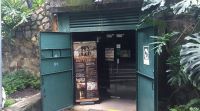Associate Professor of Business Administration Fred Hoyt was selected to participate in a Faculty Development in International Business program in Singapore and Malaysia, where he visited factories and learned about the current state of these Southeast Asian economies and their relationship with American business. He’ll return to the area with students for a May Term travel course.
It’s been 49 hours since I left Bloomington, and 15 hours since I arrived in Singapore. If you do the math, you’ll understand how long a flight I had—from Chicago basically north over the North Pole and then south to Shanghai, followed by a 9 hour layover in Shanghai (which was disappointingly devoid of distractions). Fortunately, when I arrived at the hotel in Singapore, my roommate was jetlagged himself and up.
I am reminded of a conversation Carolyn and I had when I first broached the idea of her coming to SE Asia. “I’ll come when it’s cool,” she replied. “You have two choices—hot and humid, and hot and rainy.” Notice the common denominator.
Singapore, a degree or two north of the equator, varies temperature day and night not more than ten degrees (lows in the upper 70s and highs in the upper 80s) all year round. It’s a green city (surprisingly) with an integrated park system. We’re near one—Fort Canning Hill, which contains the  “Battle Box,” the high command post where the British generals gathered February 15, 1942, and discussed whether they had any alternative to surrendering to the Japanese armies; Japan had landed bicycles and troops up the Malay Peninsula after Pearl Harbor and biked South to besiege the so-called Gibraltar of the East. The Battle Box is now a museum which recreates the last day of Britain’s supremacy in the East—with wax-like characters that are a spitting image of the participants, including General Percival, who wanted to continue to fight on, but his staff said there was little ammunition and no water left; even then, Singapore was bereft of resources, including water. Today, the city’s water comes in large part from Malaysia, but Singapore is trying to become self sufficient by recycling water and reclaiming water from the sea.
“Battle Box,” the high command post where the British generals gathered February 15, 1942, and discussed whether they had any alternative to surrendering to the Japanese armies; Japan had landed bicycles and troops up the Malay Peninsula after Pearl Harbor and biked South to besiege the so-called Gibraltar of the East. The Battle Box is now a museum which recreates the last day of Britain’s supremacy in the East—with wax-like characters that are a spitting image of the participants, including General Percival, who wanted to continue to fight on, but his staff said there was little ammunition and no water left; even then, Singapore was bereft of resources, including water. Today, the city’s water comes in large part from Malaysia, but Singapore is trying to become self sufficient by recycling water and reclaiming water from the sea.
There’s a metaphor in that for the kind of city, or rather city-state, Singapore has become. As late as the 1950s a Third World country, Singapore’s government (the Political Action Party which has ruled Singapore since independence) has turned it in many ways into a model—safe, well run, a great place to do business and a great place to live—with an income level of $36,000, which I believe is higher than the figure from Great Britain.
One of its advantages has been its advantage since even before Sir Stamford Raffles set foot on the island in 1819 to claim it for the British Empire—its location. With a naturally fine harbor, Singapore (named for a lion supposedly shot by a Sultan—a Singha is a lion in Bahasa Malaysian) sits astride the major East-West trade routes; something like 50 percent of the world’s trade passes through the Straits of Malacca (even today, the port is the first or second largest container port in the world [by some counts, Shanghai is bigger]).
The government of the 4 million Singaporeans (plus a floating population of skilled and unskilled expatriate labor of nearly 2 million temporary residents) seems to many to have managed the city with the long term in mind in a way that many businesses would envy.
To take one example, the Economic Development Council has decided that Singapore must move forward or fall behind; its current niche of sophisticated high-tech manufacturing is being occupied by China, so Singapore has gone out of its way to attract companies and especially educational organizations that set benchmarks for best practices, in its belief that education long term is essential. Hence, in an old colonial building behind our hotel sits a branch of the University of Chicago Graduate School of Business. (ed. Interestingly, in 2014, UC moved its main Asian campus to Hong Kong). The government talked the University of Illinois into putting a specific computer program in place here, and has made several successful efforts to attract business in what it deems significant sectors: 1,500 American firms call Singapore its regional headquarters, along with 3,500 Chinese mainland companies, and 10,000 others. It probably helps that Singapore can promise both safety for people and safety for a company’s intellectual property rights.
We had an enlightening visit with members of the U.S. Embassy staff about American prospects in Singapore—whose presentation will I hope be at least duplicated in May when I take IWU students back here. You’ve read some of their contributions to me in the paragraph above, but one of their comments could easily close this blog—he described Singapore as, “Asia for beginners.” It’s one reason I’m glad we’re starting here first, then proceeding to Malaysia.
Have a great day.